Financial Analysis and Decision-Making Project, Scenario A & B
VerifiedAdded on 2022/11/30
|16
|5084
|74
Project
AI Summary
This project analyzes financial decision-making processes within the Marks & Spencer company, focusing on approaches, techniques, and factors contributing to effective decision-making. Scenario A evaluates approaches, stakeholder management, management accounting techniques, fraud detection, and ethical decision-making. Scenario B analyzes financial performance through ratio calculation, operational and strategic decisions, investment appraisal techniques, and long-term sustainability considerations. The project explores key financial management principles, including risk and return, time value of money, profitability, and portfolio diversity. It also examines techniques for fraud detection and ethical decision-making approaches. The analysis provides insights into how Marks & Spencer manages stakeholders, controls costs, and makes investment decisions to maximize shareholder value and ensure long-term financial health. The project also includes a reflection on the learning gained from the analysis of the case study.

PROJECT
1
1
Paraphrase This Document
Need a fresh take? Get an instant paraphrase of this document with our AI Paraphraser
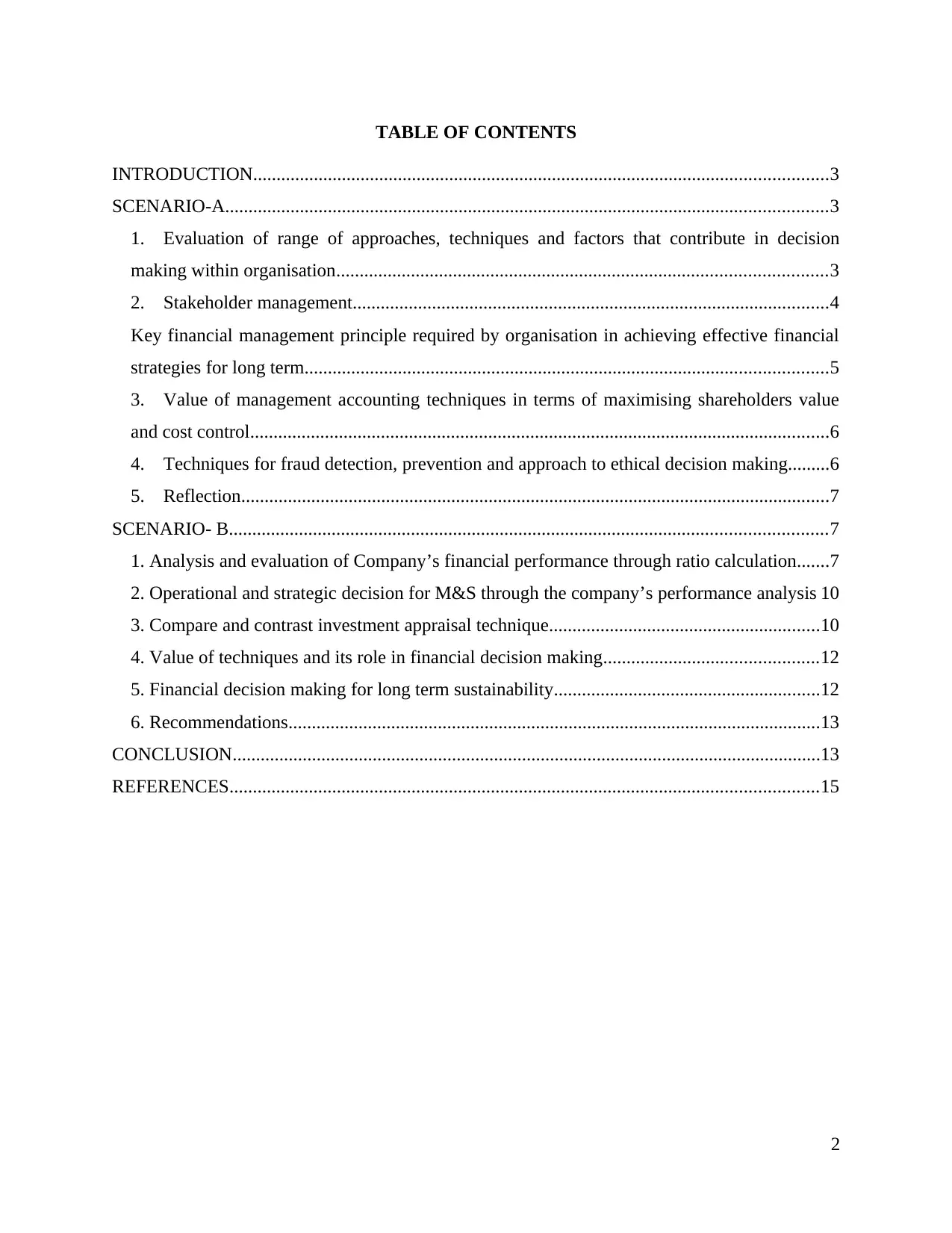
TABLE OF CONTENTS
INTRODUCTION...........................................................................................................................3
SCENARIO-A.................................................................................................................................3
1. Evaluation of range of approaches, techniques and factors that contribute in decision
making within organisation.........................................................................................................3
2. Stakeholder management......................................................................................................4
Key financial management principle required by organisation in achieving effective financial
strategies for long term................................................................................................................5
3. Value of management accounting techniques in terms of maximising shareholders value
and cost control............................................................................................................................6
4. Techniques for fraud detection, prevention and approach to ethical decision making.........6
5. Reflection..............................................................................................................................7
SCENARIO- B................................................................................................................................7
1. Analysis and evaluation of Company’s financial performance through ratio calculation.......7
2. Operational and strategic decision for M&S through the company’s performance analysis 10
3. Compare and contrast investment appraisal technique..........................................................10
4. Value of techniques and its role in financial decision making..............................................12
5. Financial decision making for long term sustainability.........................................................12
6. Recommendations..................................................................................................................13
CONCLUSION..............................................................................................................................13
REFERENCES..............................................................................................................................15
2
INTRODUCTION...........................................................................................................................3
SCENARIO-A.................................................................................................................................3
1. Evaluation of range of approaches, techniques and factors that contribute in decision
making within organisation.........................................................................................................3
2. Stakeholder management......................................................................................................4
Key financial management principle required by organisation in achieving effective financial
strategies for long term................................................................................................................5
3. Value of management accounting techniques in terms of maximising shareholders value
and cost control............................................................................................................................6
4. Techniques for fraud detection, prevention and approach to ethical decision making.........6
5. Reflection..............................................................................................................................7
SCENARIO- B................................................................................................................................7
1. Analysis and evaluation of Company’s financial performance through ratio calculation.......7
2. Operational and strategic decision for M&S through the company’s performance analysis 10
3. Compare and contrast investment appraisal technique..........................................................10
4. Value of techniques and its role in financial decision making..............................................12
5. Financial decision making for long term sustainability.........................................................12
6. Recommendations..................................................................................................................13
CONCLUSION..............................................................................................................................13
REFERENCES..............................................................................................................................15
2
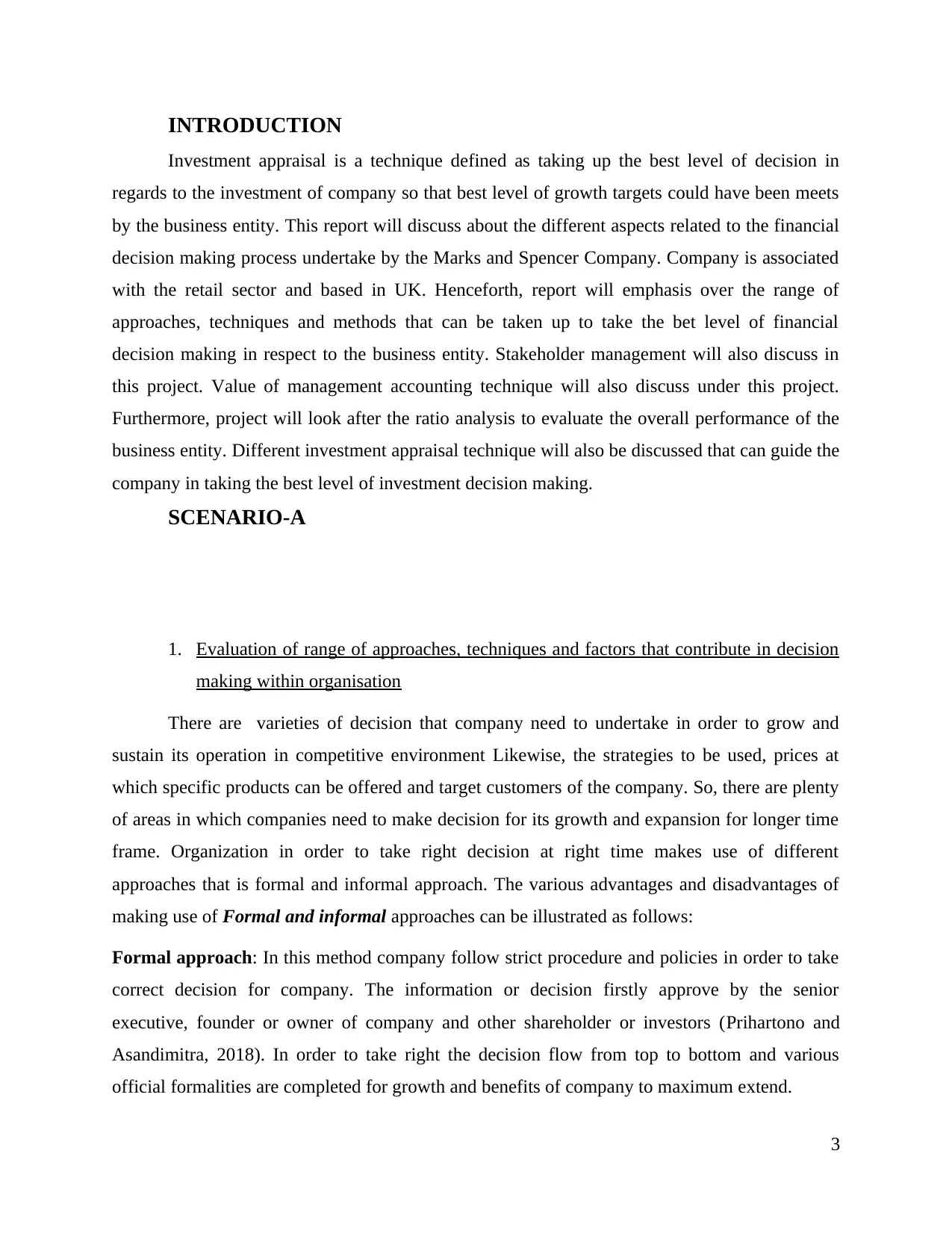
INTRODUCTION
Investment appraisal is a technique defined as taking up the best level of decision in
regards to the investment of company so that best level of growth targets could have been meets
by the business entity. This report will discuss about the different aspects related to the financial
decision making process undertake by the Marks and Spencer Company. Company is associated
with the retail sector and based in UK. Henceforth, report will emphasis over the range of
approaches, techniques and methods that can be taken up to take the bet level of financial
decision making in respect to the business entity. Stakeholder management will also discuss in
this project. Value of management accounting technique will also discuss under this project.
Furthermore, project will look after the ratio analysis to evaluate the overall performance of the
business entity. Different investment appraisal technique will also be discussed that can guide the
company in taking the best level of investment decision making.
SCENARIO-A
1. Evaluation of range of approaches, techniques and factors that contribute in decision
making within organisation
There are varieties of decision that company need to undertake in order to grow and
sustain its operation in competitive environment Likewise, the strategies to be used, prices at
which specific products can be offered and target customers of the company. So, there are plenty
of areas in which companies need to make decision for its growth and expansion for longer time
frame. Organization in order to take right decision at right time makes use of different
approaches that is formal and informal approach. The various advantages and disadvantages of
making use of Formal and informal approaches can be illustrated as follows:
Formal approach: In this method company follow strict procedure and policies in order to take
correct decision for company. The information or decision firstly approve by the senior
executive, founder or owner of company and other shareholder or investors (Prihartono and
Asandimitra, 2018). In order to take right the decision flow from top to bottom and various
official formalities are completed for growth and benefits of company to maximum extend.
3
Investment appraisal is a technique defined as taking up the best level of decision in
regards to the investment of company so that best level of growth targets could have been meets
by the business entity. This report will discuss about the different aspects related to the financial
decision making process undertake by the Marks and Spencer Company. Company is associated
with the retail sector and based in UK. Henceforth, report will emphasis over the range of
approaches, techniques and methods that can be taken up to take the bet level of financial
decision making in respect to the business entity. Stakeholder management will also discuss in
this project. Value of management accounting technique will also discuss under this project.
Furthermore, project will look after the ratio analysis to evaluate the overall performance of the
business entity. Different investment appraisal technique will also be discussed that can guide the
company in taking the best level of investment decision making.
SCENARIO-A
1. Evaluation of range of approaches, techniques and factors that contribute in decision
making within organisation
There are varieties of decision that company need to undertake in order to grow and
sustain its operation in competitive environment Likewise, the strategies to be used, prices at
which specific products can be offered and target customers of the company. So, there are plenty
of areas in which companies need to make decision for its growth and expansion for longer time
frame. Organization in order to take right decision at right time makes use of different
approaches that is formal and informal approach. The various advantages and disadvantages of
making use of Formal and informal approaches can be illustrated as follows:
Formal approach: In this method company follow strict procedure and policies in order to take
correct decision for company. The information or decision firstly approve by the senior
executive, founder or owner of company and other shareholder or investors (Prihartono and
Asandimitra, 2018). In order to take right the decision flow from top to bottom and various
official formalities are completed for growth and benefits of company to maximum extend.
3
⊘ This is a preview!⊘
Do you want full access?
Subscribe today to unlock all pages.

Trusted by 1+ million students worldwide
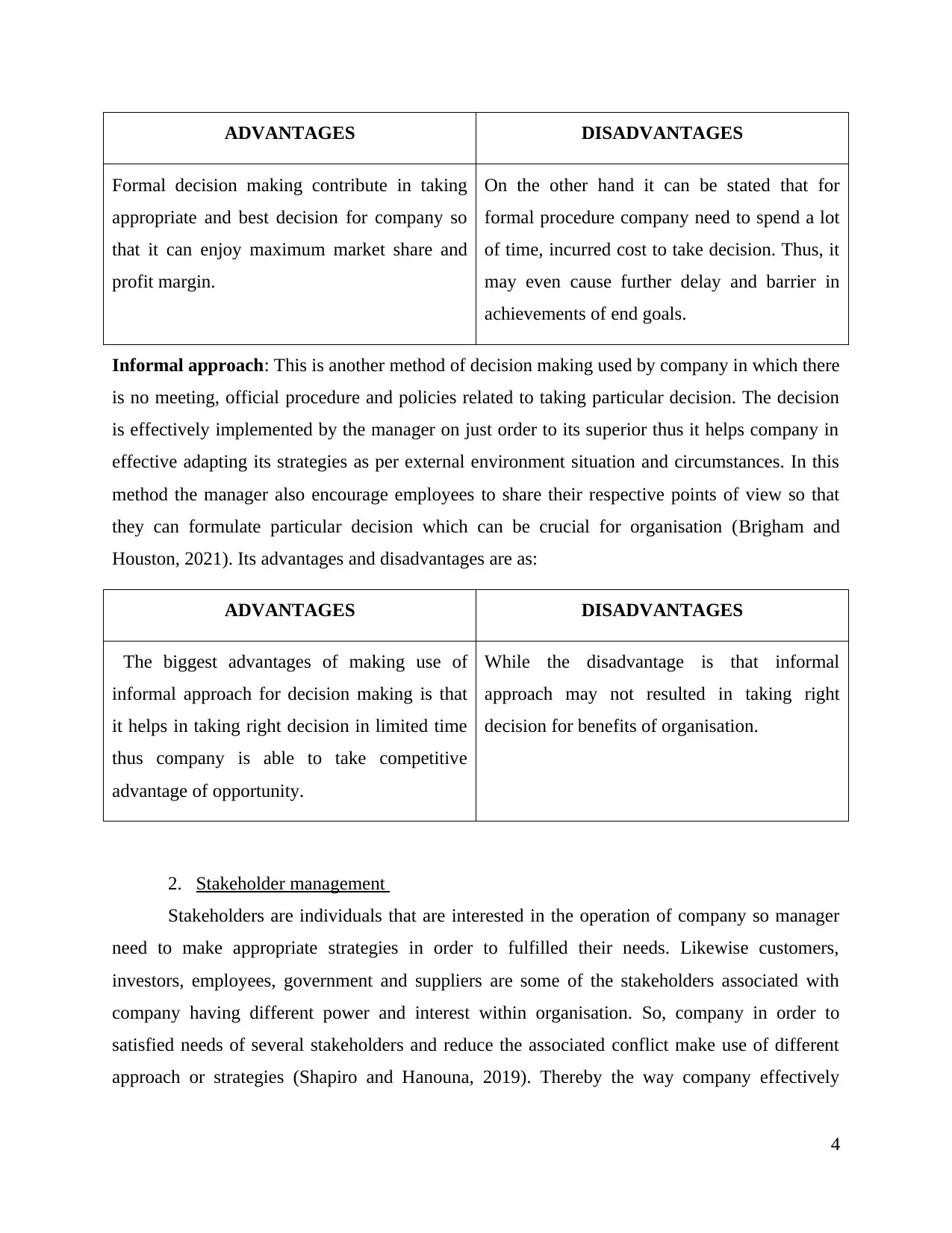
ADVANTAGES DISADVANTAGES
Formal decision making contribute in taking
appropriate and best decision for company so
that it can enjoy maximum market share and
profit margin.
On the other hand it can be stated that for
formal procedure company need to spend a lot
of time, incurred cost to take decision. Thus, it
may even cause further delay and barrier in
achievements of end goals.
Informal approach: This is another method of decision making used by company in which there
is no meeting, official procedure and policies related to taking particular decision. The decision
is effectively implemented by the manager on just order to its superior thus it helps company in
effective adapting its strategies as per external environment situation and circumstances. In this
method the manager also encourage employees to share their respective points of view so that
they can formulate particular decision which can be crucial for organisation (Brigham and
Houston, 2021). Its advantages and disadvantages are as:
ADVANTAGES DISADVANTAGES
The biggest advantages of making use of
informal approach for decision making is that
it helps in taking right decision in limited time
thus company is able to take competitive
advantage of opportunity.
While the disadvantage is that informal
approach may not resulted in taking right
decision for benefits of organisation.
2. Stakeholder management
Stakeholders are individuals that are interested in the operation of company so manager
need to make appropriate strategies in order to fulfilled their needs. Likewise customers,
investors, employees, government and suppliers are some of the stakeholders associated with
company having different power and interest within organisation. So, company in order to
satisfied needs of several stakeholders and reduce the associated conflict make use of different
approach or strategies (Shapiro and Hanouna, 2019). Thereby the way company effectively
4
Formal decision making contribute in taking
appropriate and best decision for company so
that it can enjoy maximum market share and
profit margin.
On the other hand it can be stated that for
formal procedure company need to spend a lot
of time, incurred cost to take decision. Thus, it
may even cause further delay and barrier in
achievements of end goals.
Informal approach: This is another method of decision making used by company in which there
is no meeting, official procedure and policies related to taking particular decision. The decision
is effectively implemented by the manager on just order to its superior thus it helps company in
effective adapting its strategies as per external environment situation and circumstances. In this
method the manager also encourage employees to share their respective points of view so that
they can formulate particular decision which can be crucial for organisation (Brigham and
Houston, 2021). Its advantages and disadvantages are as:
ADVANTAGES DISADVANTAGES
The biggest advantages of making use of
informal approach for decision making is that
it helps in taking right decision in limited time
thus company is able to take competitive
advantage of opportunity.
While the disadvantage is that informal
approach may not resulted in taking right
decision for benefits of organisation.
2. Stakeholder management
Stakeholders are individuals that are interested in the operation of company so manager
need to make appropriate strategies in order to fulfilled their needs. Likewise customers,
investors, employees, government and suppliers are some of the stakeholders associated with
company having different power and interest within organisation. So, company in order to
satisfied needs of several stakeholders and reduce the associated conflict make use of different
approach or strategies (Shapiro and Hanouna, 2019). Thereby the way company effectively
4
Paraphrase This Document
Need a fresh take? Get an instant paraphrase of this document with our AI Paraphraser
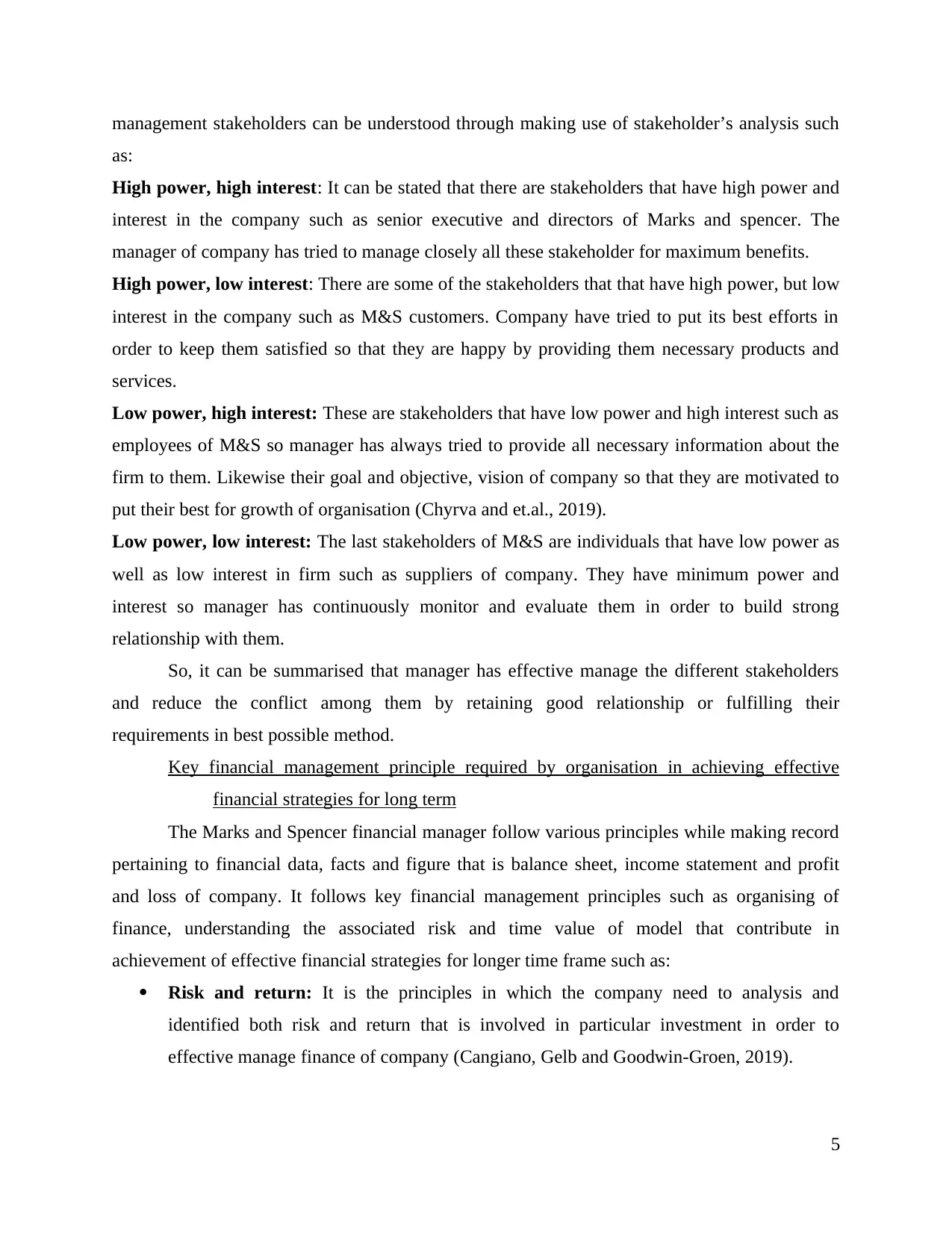
management stakeholders can be understood through making use of stakeholder’s analysis such
as:
High power, high interest: It can be stated that there are stakeholders that have high power and
interest in the company such as senior executive and directors of Marks and spencer. The
manager of company has tried to manage closely all these stakeholder for maximum benefits.
High power, low interest: There are some of the stakeholders that that have high power, but low
interest in the company such as M&S customers. Company have tried to put its best efforts in
order to keep them satisfied so that they are happy by providing them necessary products and
services.
Low power, high interest: These are stakeholders that have low power and high interest such as
employees of M&S so manager has always tried to provide all necessary information about the
firm to them. Likewise their goal and objective, vision of company so that they are motivated to
put their best for growth of organisation (Chyrva and et.al., 2019).
Low power, low interest: The last stakeholders of M&S are individuals that have low power as
well as low interest in firm such as suppliers of company. They have minimum power and
interest so manager has continuously monitor and evaluate them in order to build strong
relationship with them.
So, it can be summarised that manager has effective manage the different stakeholders
and reduce the conflict among them by retaining good relationship or fulfilling their
requirements in best possible method.
Key financial management principle required by organisation in achieving effective
financial strategies for long term
The Marks and Spencer financial manager follow various principles while making record
pertaining to financial data, facts and figure that is balance sheet, income statement and profit
and loss of company. It follows key financial management principles such as organising of
finance, understanding the associated risk and time value of model that contribute in
achievement of effective financial strategies for longer time frame such as:
Risk and return: It is the principles in which the company need to analysis and
identified both risk and return that is involved in particular investment in order to
effective manage finance of company (Cangiano, Gelb and Goodwin-Groen, 2019).
5
as:
High power, high interest: It can be stated that there are stakeholders that have high power and
interest in the company such as senior executive and directors of Marks and spencer. The
manager of company has tried to manage closely all these stakeholder for maximum benefits.
High power, low interest: There are some of the stakeholders that that have high power, but low
interest in the company such as M&S customers. Company have tried to put its best efforts in
order to keep them satisfied so that they are happy by providing them necessary products and
services.
Low power, high interest: These are stakeholders that have low power and high interest such as
employees of M&S so manager has always tried to provide all necessary information about the
firm to them. Likewise their goal and objective, vision of company so that they are motivated to
put their best for growth of organisation (Chyrva and et.al., 2019).
Low power, low interest: The last stakeholders of M&S are individuals that have low power as
well as low interest in firm such as suppliers of company. They have minimum power and
interest so manager has continuously monitor and evaluate them in order to build strong
relationship with them.
So, it can be summarised that manager has effective manage the different stakeholders
and reduce the conflict among them by retaining good relationship or fulfilling their
requirements in best possible method.
Key financial management principle required by organisation in achieving effective
financial strategies for long term
The Marks and Spencer financial manager follow various principles while making record
pertaining to financial data, facts and figure that is balance sheet, income statement and profit
and loss of company. It follows key financial management principles such as organising of
finance, understanding the associated risk and time value of model that contribute in
achievement of effective financial strategies for longer time frame such as:
Risk and return: It is the principles in which the company need to analysis and
identified both risk and return that is involved in particular investment in order to
effective manage finance of company (Cangiano, Gelb and Goodwin-Groen, 2019).
5
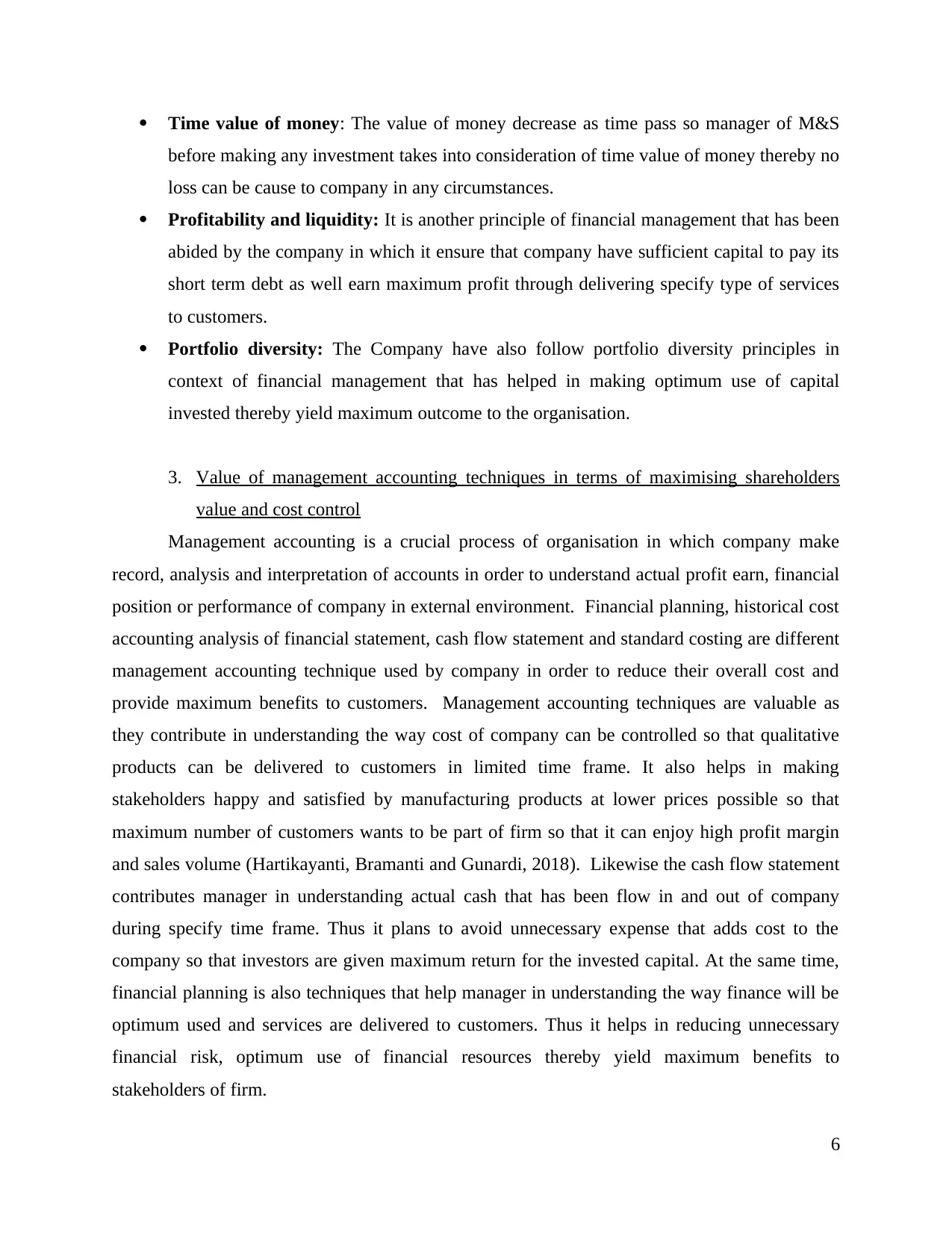
Time value of money: The value of money decrease as time pass so manager of M&S
before making any investment takes into consideration of time value of money thereby no
loss can be cause to company in any circumstances.
Profitability and liquidity: It is another principle of financial management that has been
abided by the company in which it ensure that company have sufficient capital to pay its
short term debt as well earn maximum profit through delivering specify type of services
to customers.
Portfolio diversity: The Company have also follow portfolio diversity principles in
context of financial management that has helped in making optimum use of capital
invested thereby yield maximum outcome to the organisation.
3. Value of management accounting techniques in terms of maximising shareholders
value and cost control
Management accounting is a crucial process of organisation in which company make
record, analysis and interpretation of accounts in order to understand actual profit earn, financial
position or performance of company in external environment. Financial planning, historical cost
accounting analysis of financial statement, cash flow statement and standard costing are different
management accounting technique used by company in order to reduce their overall cost and
provide maximum benefits to customers. Management accounting techniques are valuable as
they contribute in understanding the way cost of company can be controlled so that qualitative
products can be delivered to customers in limited time frame. It also helps in making
stakeholders happy and satisfied by manufacturing products at lower prices possible so that
maximum number of customers wants to be part of firm so that it can enjoy high profit margin
and sales volume (Hartikayanti, Bramanti and Gunardi, 2018). Likewise the cash flow statement
contributes manager in understanding actual cash that has been flow in and out of company
during specify time frame. Thus it plans to avoid unnecessary expense that adds cost to the
company so that investors are given maximum return for the invested capital. At the same time,
financial planning is also techniques that help manager in understanding the way finance will be
optimum used and services are delivered to customers. Thus it helps in reducing unnecessary
financial risk, optimum use of financial resources thereby yield maximum benefits to
stakeholders of firm.
6
before making any investment takes into consideration of time value of money thereby no
loss can be cause to company in any circumstances.
Profitability and liquidity: It is another principle of financial management that has been
abided by the company in which it ensure that company have sufficient capital to pay its
short term debt as well earn maximum profit through delivering specify type of services
to customers.
Portfolio diversity: The Company have also follow portfolio diversity principles in
context of financial management that has helped in making optimum use of capital
invested thereby yield maximum outcome to the organisation.
3. Value of management accounting techniques in terms of maximising shareholders
value and cost control
Management accounting is a crucial process of organisation in which company make
record, analysis and interpretation of accounts in order to understand actual profit earn, financial
position or performance of company in external environment. Financial planning, historical cost
accounting analysis of financial statement, cash flow statement and standard costing are different
management accounting technique used by company in order to reduce their overall cost and
provide maximum benefits to customers. Management accounting techniques are valuable as
they contribute in understanding the way cost of company can be controlled so that qualitative
products can be delivered to customers in limited time frame. It also helps in making
stakeholders happy and satisfied by manufacturing products at lower prices possible so that
maximum number of customers wants to be part of firm so that it can enjoy high profit margin
and sales volume (Hartikayanti, Bramanti and Gunardi, 2018). Likewise the cash flow statement
contributes manager in understanding actual cash that has been flow in and out of company
during specify time frame. Thus it plans to avoid unnecessary expense that adds cost to the
company so that investors are given maximum return for the invested capital. At the same time,
financial planning is also techniques that help manager in understanding the way finance will be
optimum used and services are delivered to customers. Thus it helps in reducing unnecessary
financial risk, optimum use of financial resources thereby yield maximum benefits to
stakeholders of firm.
6
⊘ This is a preview!⊘
Do you want full access?
Subscribe today to unlock all pages.

Trusted by 1+ million students worldwide
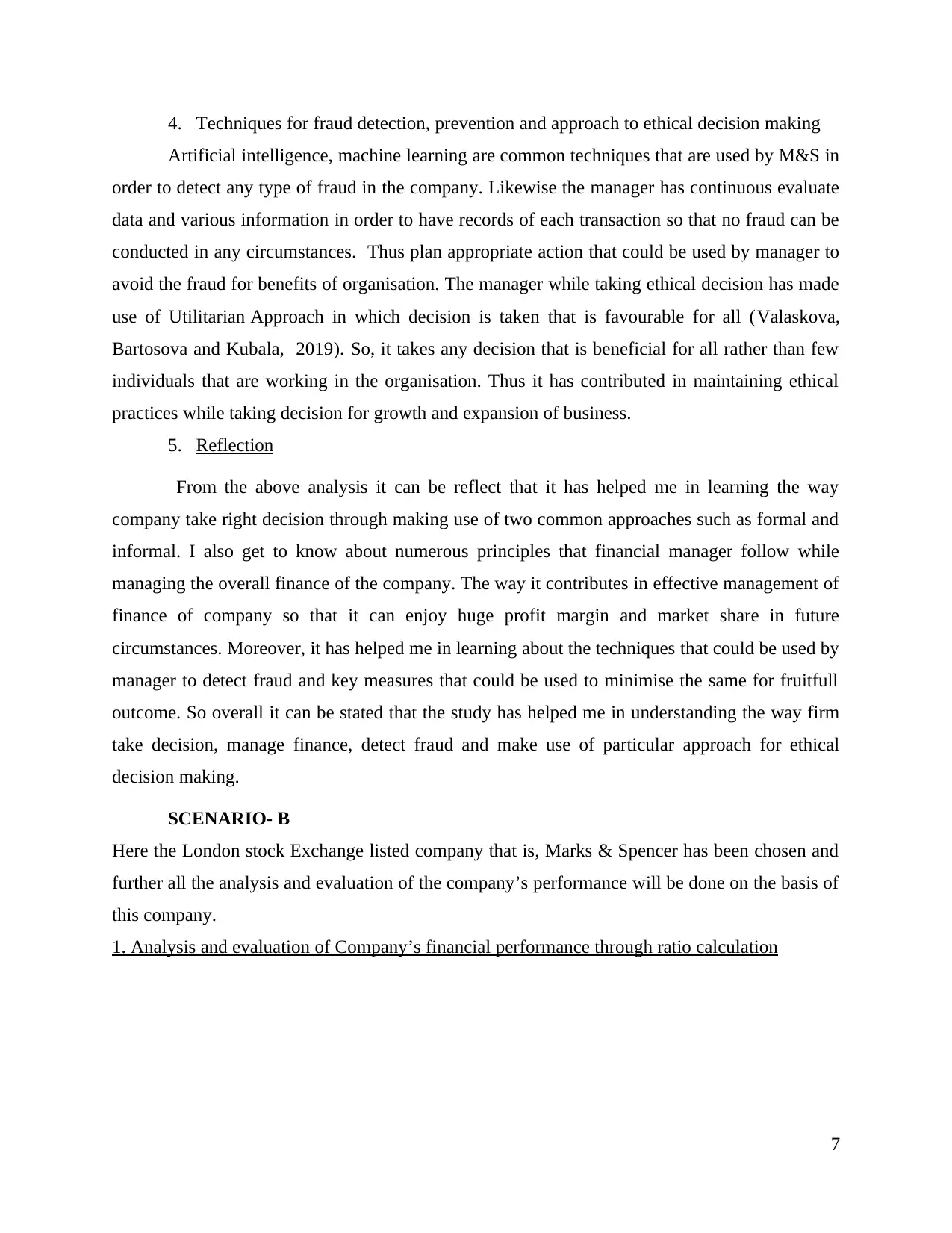
4. Techniques for fraud detection, prevention and approach to ethical decision making
Artificial intelligence, machine learning are common techniques that are used by M&S in
order to detect any type of fraud in the company. Likewise the manager has continuous evaluate
data and various information in order to have records of each transaction so that no fraud can be
conducted in any circumstances. Thus plan appropriate action that could be used by manager to
avoid the fraud for benefits of organisation. The manager while taking ethical decision has made
use of Utilitarian Approach in which decision is taken that is favourable for all (Valaskova,
Bartosova and Kubala, 2019). So, it takes any decision that is beneficial for all rather than few
individuals that are working in the organisation. Thus it has contributed in maintaining ethical
practices while taking decision for growth and expansion of business.
5. Reflection
From the above analysis it can be reflect that it has helped me in learning the way
company take right decision through making use of two common approaches such as formal and
informal. I also get to know about numerous principles that financial manager follow while
managing the overall finance of the company. The way it contributes in effective management of
finance of company so that it can enjoy huge profit margin and market share in future
circumstances. Moreover, it has helped me in learning about the techniques that could be used by
manager to detect fraud and key measures that could be used to minimise the same for fruitfull
outcome. So overall it can be stated that the study has helped me in understanding the way firm
take decision, manage finance, detect fraud and make use of particular approach for ethical
decision making.
SCENARIO- B
Here the London stock Exchange listed company that is, Marks & Spencer has been chosen and
further all the analysis and evaluation of the company’s performance will be done on the basis of
this company.
1. Analysis and evaluation of Company’s financial performance through ratio calculation
7
Artificial intelligence, machine learning are common techniques that are used by M&S in
order to detect any type of fraud in the company. Likewise the manager has continuous evaluate
data and various information in order to have records of each transaction so that no fraud can be
conducted in any circumstances. Thus plan appropriate action that could be used by manager to
avoid the fraud for benefits of organisation. The manager while taking ethical decision has made
use of Utilitarian Approach in which decision is taken that is favourable for all (Valaskova,
Bartosova and Kubala, 2019). So, it takes any decision that is beneficial for all rather than few
individuals that are working in the organisation. Thus it has contributed in maintaining ethical
practices while taking decision for growth and expansion of business.
5. Reflection
From the above analysis it can be reflect that it has helped me in learning the way
company take right decision through making use of two common approaches such as formal and
informal. I also get to know about numerous principles that financial manager follow while
managing the overall finance of the company. The way it contributes in effective management of
finance of company so that it can enjoy huge profit margin and market share in future
circumstances. Moreover, it has helped me in learning about the techniques that could be used by
manager to detect fraud and key measures that could be used to minimise the same for fruitfull
outcome. So overall it can be stated that the study has helped me in understanding the way firm
take decision, manage finance, detect fraud and make use of particular approach for ethical
decision making.
SCENARIO- B
Here the London stock Exchange listed company that is, Marks & Spencer has been chosen and
further all the analysis and evaluation of the company’s performance will be done on the basis of
this company.
1. Analysis and evaluation of Company’s financial performance through ratio calculation
7
Paraphrase This Document
Need a fresh take? Get an instant paraphrase of this document with our AI Paraphraser
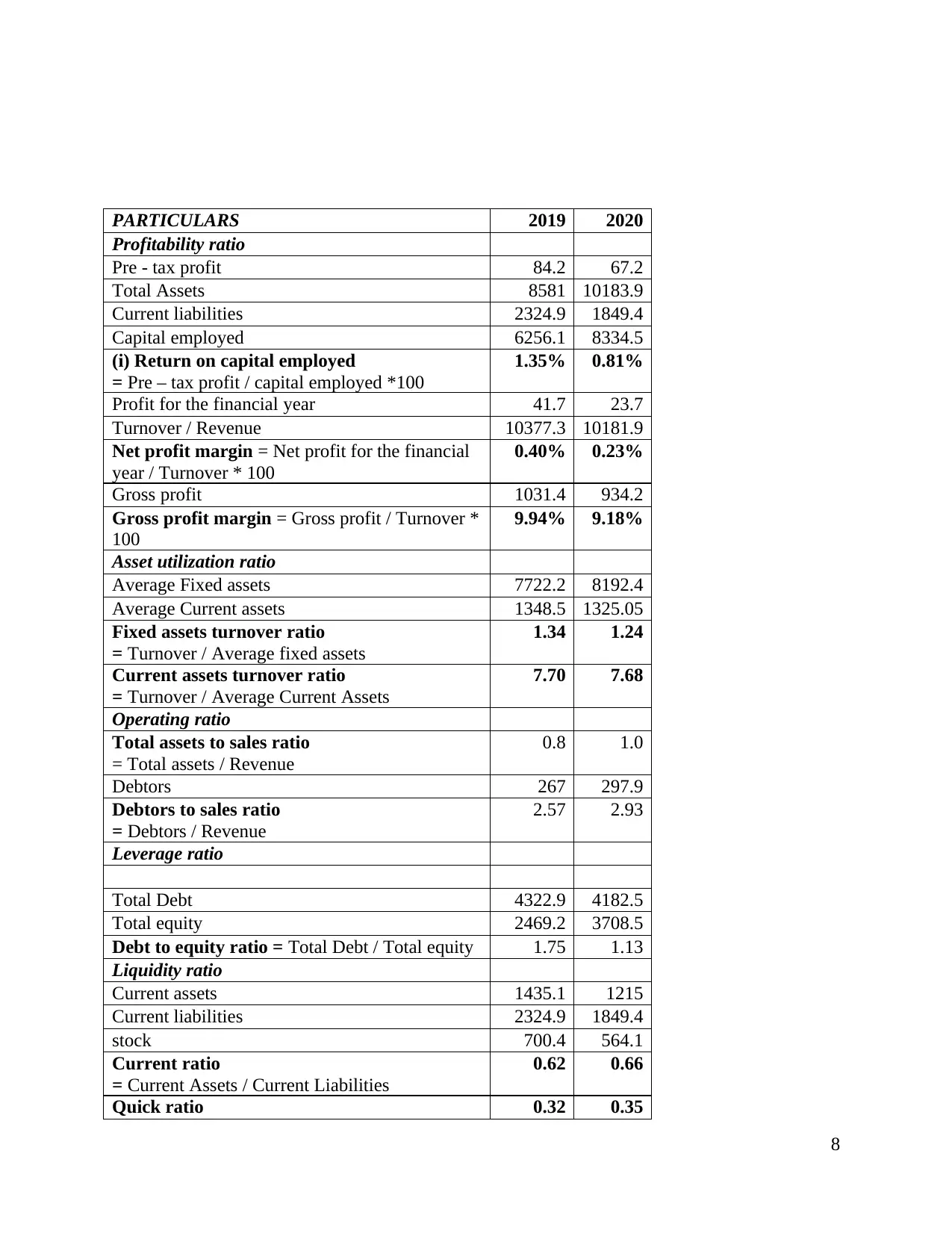
PARTICULARS 2019 2020
Profitability ratio
Pre - tax profit 84.2 67.2
Total Assets 8581 10183.9
Current liabilities 2324.9 1849.4
Capital employed 6256.1 8334.5
(i) Return on capital employed
= Pre – tax profit / capital employed *100
1.35% 0.81%
Profit for the financial year 41.7 23.7
Turnover / Revenue 10377.3 10181.9
Net profit margin = Net profit for the financial
year / Turnover * 100
0.40% 0.23%
Gross profit 1031.4 934.2
Gross profit margin = Gross profit / Turnover *
100
9.94% 9.18%
Asset utilization ratio
Average Fixed assets 7722.2 8192.4
Average Current assets 1348.5 1325.05
Fixed assets turnover ratio
= Turnover / Average fixed assets
1.34 1.24
Current assets turnover ratio
= Turnover / Average Current Assets
7.70 7.68
Operating ratio
Total assets to sales ratio
= Total assets / Revenue
0.8 1.0
Debtors 267 297.9
Debtors to sales ratio
= Debtors / Revenue
2.57 2.93
Leverage ratio
Total Debt 4322.9 4182.5
Total equity 2469.2 3708.5
Debt to equity ratio = Total Debt / Total equity 1.75 1.13
Liquidity ratio
Current assets 1435.1 1215
Current liabilities 2324.9 1849.4
stock 700.4 564.1
Current ratio
= Current Assets / Current Liabilities
0.62 0.66
Quick ratio 0.32 0.35
8
Profitability ratio
Pre - tax profit 84.2 67.2
Total Assets 8581 10183.9
Current liabilities 2324.9 1849.4
Capital employed 6256.1 8334.5
(i) Return on capital employed
= Pre – tax profit / capital employed *100
1.35% 0.81%
Profit for the financial year 41.7 23.7
Turnover / Revenue 10377.3 10181.9
Net profit margin = Net profit for the financial
year / Turnover * 100
0.40% 0.23%
Gross profit 1031.4 934.2
Gross profit margin = Gross profit / Turnover *
100
9.94% 9.18%
Asset utilization ratio
Average Fixed assets 7722.2 8192.4
Average Current assets 1348.5 1325.05
Fixed assets turnover ratio
= Turnover / Average fixed assets
1.34 1.24
Current assets turnover ratio
= Turnover / Average Current Assets
7.70 7.68
Operating ratio
Total assets to sales ratio
= Total assets / Revenue
0.8 1.0
Debtors 267 297.9
Debtors to sales ratio
= Debtors / Revenue
2.57 2.93
Leverage ratio
Total Debt 4322.9 4182.5
Total equity 2469.2 3708.5
Debt to equity ratio = Total Debt / Total equity 1.75 1.13
Liquidity ratio
Current assets 1435.1 1215
Current liabilities 2324.9 1849.4
stock 700.4 564.1
Current ratio
= Current Assets / Current Liabilities
0.62 0.66
Quick ratio 0.32 0.35
8
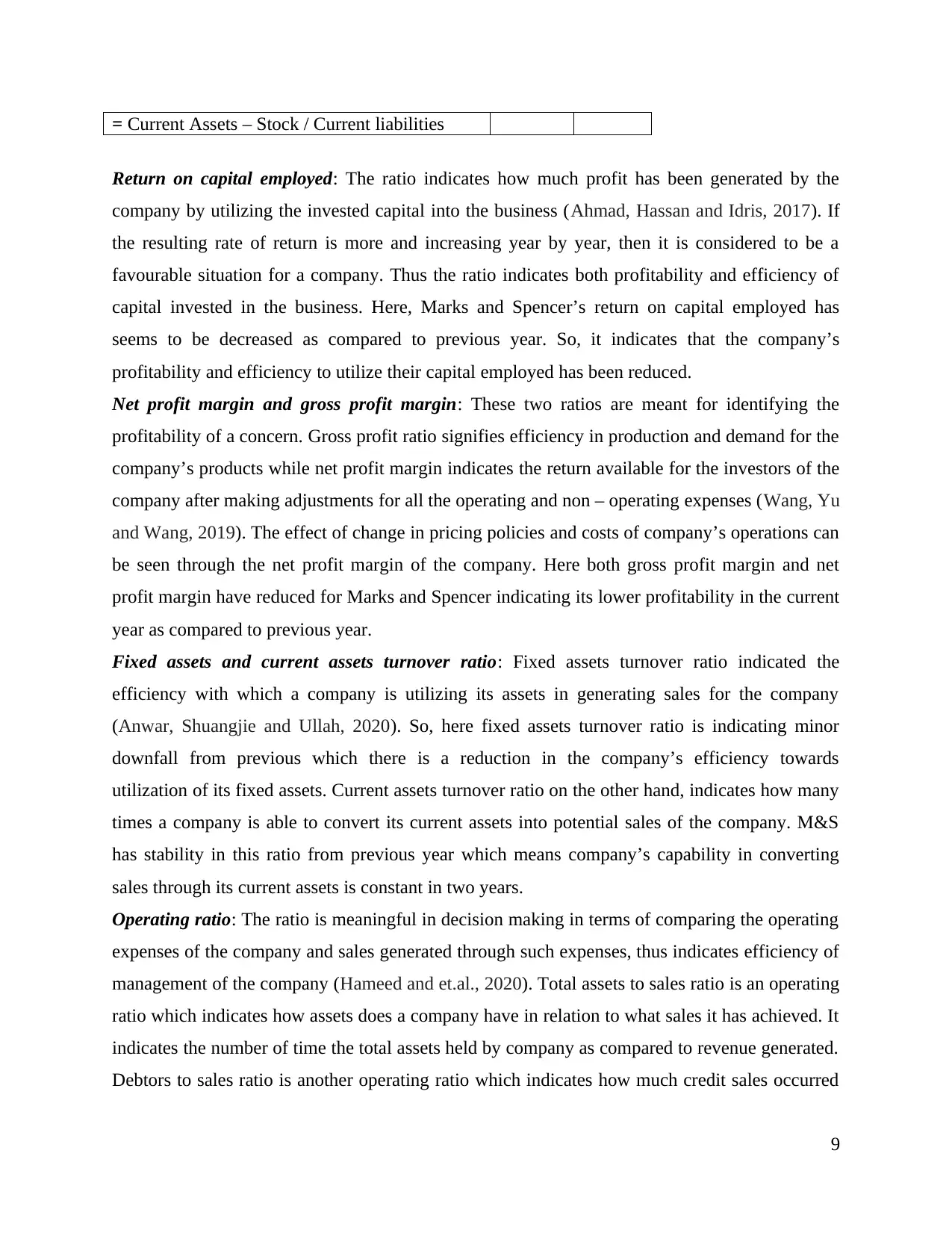
= Current Assets – Stock / Current liabilities
Return on capital employed: The ratio indicates how much profit has been generated by the
company by utilizing the invested capital into the business (Ahmad, Hassan and Idris, 2017). If
the resulting rate of return is more and increasing year by year, then it is considered to be a
favourable situation for a company. Thus the ratio indicates both profitability and efficiency of
capital invested in the business. Here, Marks and Spencer’s return on capital employed has
seems to be decreased as compared to previous year. So, it indicates that the company’s
profitability and efficiency to utilize their capital employed has been reduced.
Net profit margin and gross profit margin: These two ratios are meant for identifying the
profitability of a concern. Gross profit ratio signifies efficiency in production and demand for the
company’s products while net profit margin indicates the return available for the investors of the
company after making adjustments for all the operating and non – operating expenses (Wang, Yu
and Wang, 2019). The effect of change in pricing policies and costs of company’s operations can
be seen through the net profit margin of the company. Here both gross profit margin and net
profit margin have reduced for Marks and Spencer indicating its lower profitability in the current
year as compared to previous year.
Fixed assets and current assets turnover ratio: Fixed assets turnover ratio indicated the
efficiency with which a company is utilizing its assets in generating sales for the company
(Anwar, Shuangjie and Ullah, 2020). So, here fixed assets turnover ratio is indicating minor
downfall from previous which there is a reduction in the company’s efficiency towards
utilization of its fixed assets. Current assets turnover ratio on the other hand, indicates how many
times a company is able to convert its current assets into potential sales of the company. M&S
has stability in this ratio from previous year which means company’s capability in converting
sales through its current assets is constant in two years.
Operating ratio: The ratio is meaningful in decision making in terms of comparing the operating
expenses of the company and sales generated through such expenses, thus indicates efficiency of
management of the company (Hameed and et.al., 2020). Total assets to sales ratio is an operating
ratio which indicates how assets does a company have in relation to what sales it has achieved. It
indicates the number of time the total assets held by company as compared to revenue generated.
Debtors to sales ratio is another operating ratio which indicates how much credit sales occurred
9
Return on capital employed: The ratio indicates how much profit has been generated by the
company by utilizing the invested capital into the business (Ahmad, Hassan and Idris, 2017). If
the resulting rate of return is more and increasing year by year, then it is considered to be a
favourable situation for a company. Thus the ratio indicates both profitability and efficiency of
capital invested in the business. Here, Marks and Spencer’s return on capital employed has
seems to be decreased as compared to previous year. So, it indicates that the company’s
profitability and efficiency to utilize their capital employed has been reduced.
Net profit margin and gross profit margin: These two ratios are meant for identifying the
profitability of a concern. Gross profit ratio signifies efficiency in production and demand for the
company’s products while net profit margin indicates the return available for the investors of the
company after making adjustments for all the operating and non – operating expenses (Wang, Yu
and Wang, 2019). The effect of change in pricing policies and costs of company’s operations can
be seen through the net profit margin of the company. Here both gross profit margin and net
profit margin have reduced for Marks and Spencer indicating its lower profitability in the current
year as compared to previous year.
Fixed assets and current assets turnover ratio: Fixed assets turnover ratio indicated the
efficiency with which a company is utilizing its assets in generating sales for the company
(Anwar, Shuangjie and Ullah, 2020). So, here fixed assets turnover ratio is indicating minor
downfall from previous which there is a reduction in the company’s efficiency towards
utilization of its fixed assets. Current assets turnover ratio on the other hand, indicates how many
times a company is able to convert its current assets into potential sales of the company. M&S
has stability in this ratio from previous year which means company’s capability in converting
sales through its current assets is constant in two years.
Operating ratio: The ratio is meaningful in decision making in terms of comparing the operating
expenses of the company and sales generated through such expenses, thus indicates efficiency of
management of the company (Hameed and et.al., 2020). Total assets to sales ratio is an operating
ratio which indicates how assets does a company have in relation to what sales it has achieved. It
indicates the number of time the total assets held by company as compared to revenue generated.
Debtors to sales ratio is another operating ratio which indicates how much credit sales occurred
9
⊘ This is a preview!⊘
Do you want full access?
Subscribe today to unlock all pages.

Trusted by 1+ million students worldwide
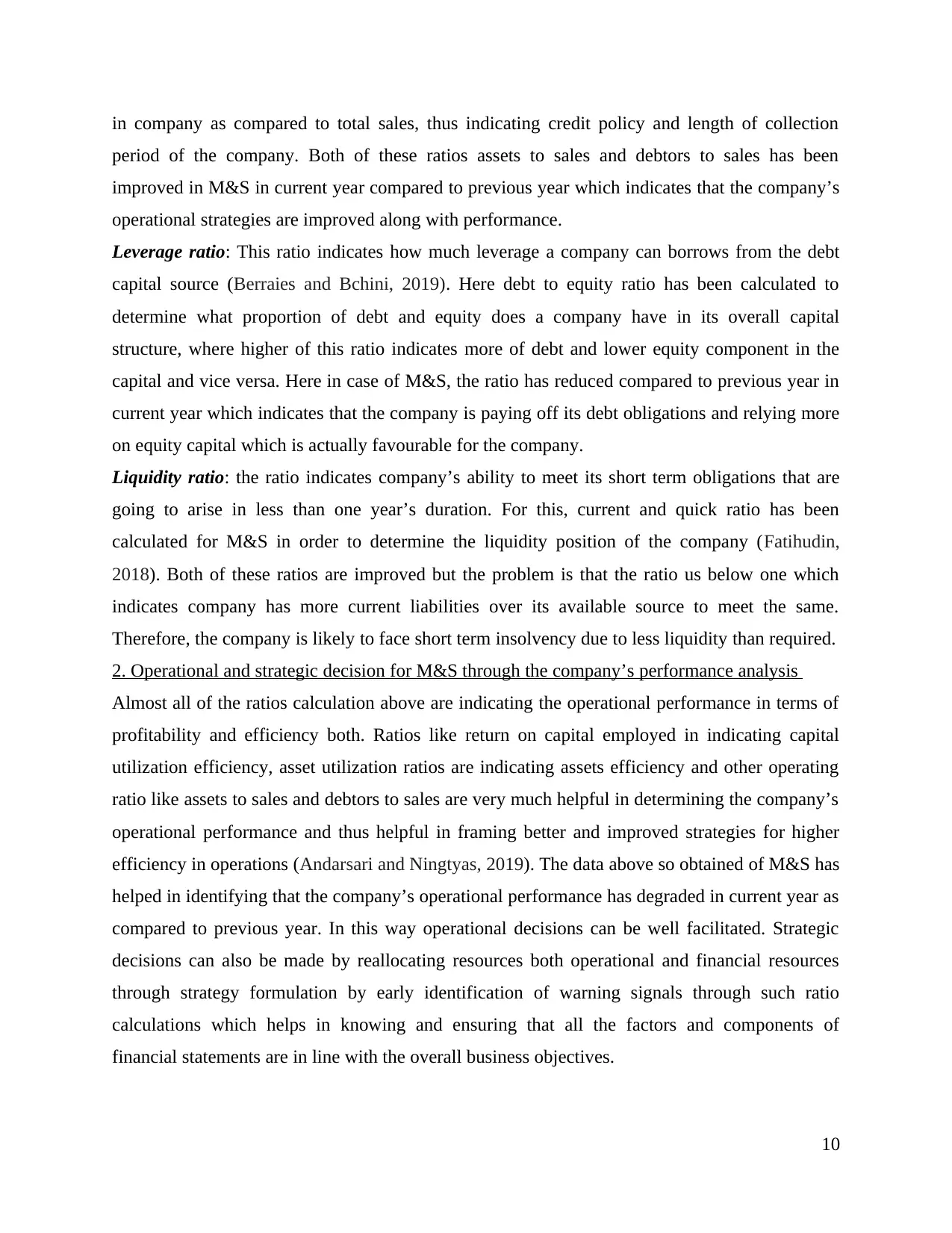
in company as compared to total sales, thus indicating credit policy and length of collection
period of the company. Both of these ratios assets to sales and debtors to sales has been
improved in M&S in current year compared to previous year which indicates that the company’s
operational strategies are improved along with performance.
Leverage ratio: This ratio indicates how much leverage a company can borrows from the debt
capital source (Berraies and Bchini, 2019). Here debt to equity ratio has been calculated to
determine what proportion of debt and equity does a company have in its overall capital
structure, where higher of this ratio indicates more of debt and lower equity component in the
capital and vice versa. Here in case of M&S, the ratio has reduced compared to previous year in
current year which indicates that the company is paying off its debt obligations and relying more
on equity capital which is actually favourable for the company.
Liquidity ratio: the ratio indicates company’s ability to meet its short term obligations that are
going to arise in less than one year’s duration. For this, current and quick ratio has been
calculated for M&S in order to determine the liquidity position of the company (Fatihudin,
2018). Both of these ratios are improved but the problem is that the ratio us below one which
indicates company has more current liabilities over its available source to meet the same.
Therefore, the company is likely to face short term insolvency due to less liquidity than required.
2. Operational and strategic decision for M&S through the company’s performance analysis
Almost all of the ratios calculation above are indicating the operational performance in terms of
profitability and efficiency both. Ratios like return on capital employed in indicating capital
utilization efficiency, asset utilization ratios are indicating assets efficiency and other operating
ratio like assets to sales and debtors to sales are very much helpful in determining the company’s
operational performance and thus helpful in framing better and improved strategies for higher
efficiency in operations (Andarsari and Ningtyas, 2019). The data above so obtained of M&S has
helped in identifying that the company’s operational performance has degraded in current year as
compared to previous year. In this way operational decisions can be well facilitated. Strategic
decisions can also be made by reallocating resources both operational and financial resources
through strategy formulation by early identification of warning signals through such ratio
calculations which helps in knowing and ensuring that all the factors and components of
financial statements are in line with the overall business objectives.
10
period of the company. Both of these ratios assets to sales and debtors to sales has been
improved in M&S in current year compared to previous year which indicates that the company’s
operational strategies are improved along with performance.
Leverage ratio: This ratio indicates how much leverage a company can borrows from the debt
capital source (Berraies and Bchini, 2019). Here debt to equity ratio has been calculated to
determine what proportion of debt and equity does a company have in its overall capital
structure, where higher of this ratio indicates more of debt and lower equity component in the
capital and vice versa. Here in case of M&S, the ratio has reduced compared to previous year in
current year which indicates that the company is paying off its debt obligations and relying more
on equity capital which is actually favourable for the company.
Liquidity ratio: the ratio indicates company’s ability to meet its short term obligations that are
going to arise in less than one year’s duration. For this, current and quick ratio has been
calculated for M&S in order to determine the liquidity position of the company (Fatihudin,
2018). Both of these ratios are improved but the problem is that the ratio us below one which
indicates company has more current liabilities over its available source to meet the same.
Therefore, the company is likely to face short term insolvency due to less liquidity than required.
2. Operational and strategic decision for M&S through the company’s performance analysis
Almost all of the ratios calculation above are indicating the operational performance in terms of
profitability and efficiency both. Ratios like return on capital employed in indicating capital
utilization efficiency, asset utilization ratios are indicating assets efficiency and other operating
ratio like assets to sales and debtors to sales are very much helpful in determining the company’s
operational performance and thus helpful in framing better and improved strategies for higher
efficiency in operations (Andarsari and Ningtyas, 2019). The data above so obtained of M&S has
helped in identifying that the company’s operational performance has degraded in current year as
compared to previous year. In this way operational decisions can be well facilitated. Strategic
decisions can also be made by reallocating resources both operational and financial resources
through strategy formulation by early identification of warning signals through such ratio
calculations which helps in knowing and ensuring that all the factors and components of
financial statements are in line with the overall business objectives.
10
Paraphrase This Document
Need a fresh take? Get an instant paraphrase of this document with our AI Paraphraser
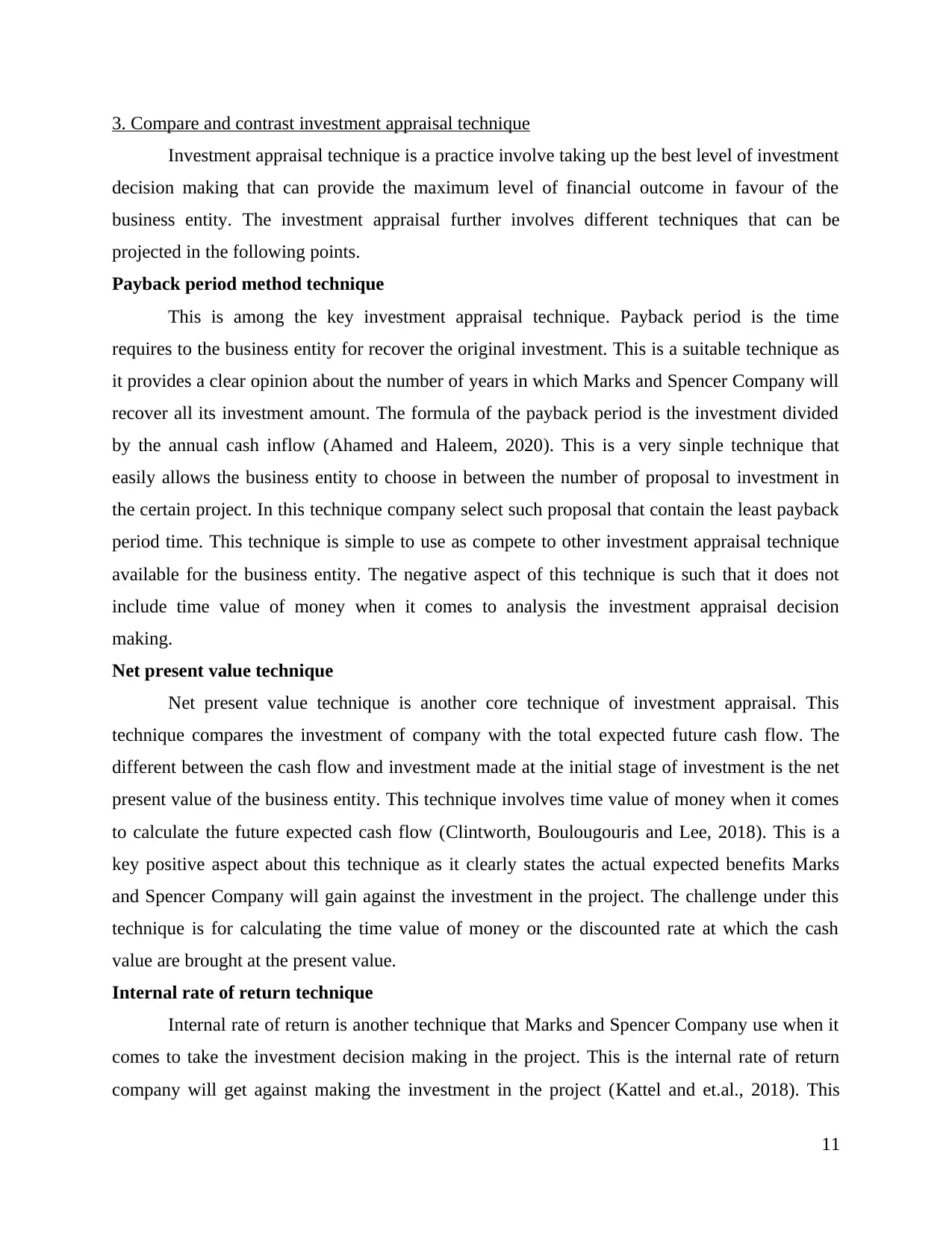
3. Compare and contrast investment appraisal technique
Investment appraisal technique is a practice involve taking up the best level of investment
decision making that can provide the maximum level of financial outcome in favour of the
business entity. The investment appraisal further involves different techniques that can be
projected in the following points.
Payback period method technique
This is among the key investment appraisal technique. Payback period is the time
requires to the business entity for recover the original investment. This is a suitable technique as
it provides a clear opinion about the number of years in which Marks and Spencer Company will
recover all its investment amount. The formula of the payback period is the investment divided
by the annual cash inflow (Ahamed and Haleem, 2020). This is a very sinple technique that
easily allows the business entity to choose in between the number of proposal to investment in
the certain project. In this technique company select such proposal that contain the least payback
period time. This technique is simple to use as compete to other investment appraisal technique
available for the business entity. The negative aspect of this technique is such that it does not
include time value of money when it comes to analysis the investment appraisal decision
making.
Net present value technique
Net present value technique is another core technique of investment appraisal. This
technique compares the investment of company with the total expected future cash flow. The
different between the cash flow and investment made at the initial stage of investment is the net
present value of the business entity. This technique involves time value of money when it comes
to calculate the future expected cash flow (Clintworth, Boulougouris and Lee, 2018). This is a
key positive aspect about this technique as it clearly states the actual expected benefits Marks
and Spencer Company will gain against the investment in the project. The challenge under this
technique is for calculating the time value of money or the discounted rate at which the cash
value are brought at the present value.
Internal rate of return technique
Internal rate of return is another technique that Marks and Spencer Company use when it
comes to take the investment decision making in the project. This is the internal rate of return
company will get against making the investment in the project (Kattel and et.al., 2018). This
11
Investment appraisal technique is a practice involve taking up the best level of investment
decision making that can provide the maximum level of financial outcome in favour of the
business entity. The investment appraisal further involves different techniques that can be
projected in the following points.
Payback period method technique
This is among the key investment appraisal technique. Payback period is the time
requires to the business entity for recover the original investment. This is a suitable technique as
it provides a clear opinion about the number of years in which Marks and Spencer Company will
recover all its investment amount. The formula of the payback period is the investment divided
by the annual cash inflow (Ahamed and Haleem, 2020). This is a very sinple technique that
easily allows the business entity to choose in between the number of proposal to investment in
the certain project. In this technique company select such proposal that contain the least payback
period time. This technique is simple to use as compete to other investment appraisal technique
available for the business entity. The negative aspect of this technique is such that it does not
include time value of money when it comes to analysis the investment appraisal decision
making.
Net present value technique
Net present value technique is another core technique of investment appraisal. This
technique compares the investment of company with the total expected future cash flow. The
different between the cash flow and investment made at the initial stage of investment is the net
present value of the business entity. This technique involves time value of money when it comes
to calculate the future expected cash flow (Clintworth, Boulougouris and Lee, 2018). This is a
key positive aspect about this technique as it clearly states the actual expected benefits Marks
and Spencer Company will gain against the investment in the project. The challenge under this
technique is for calculating the time value of money or the discounted rate at which the cash
value are brought at the present value.
Internal rate of return technique
Internal rate of return is another technique that Marks and Spencer Company use when it
comes to take the investment decision making in the project. This is the internal rate of return
company will get against making the investment in the project (Kattel and et.al., 2018). This
11
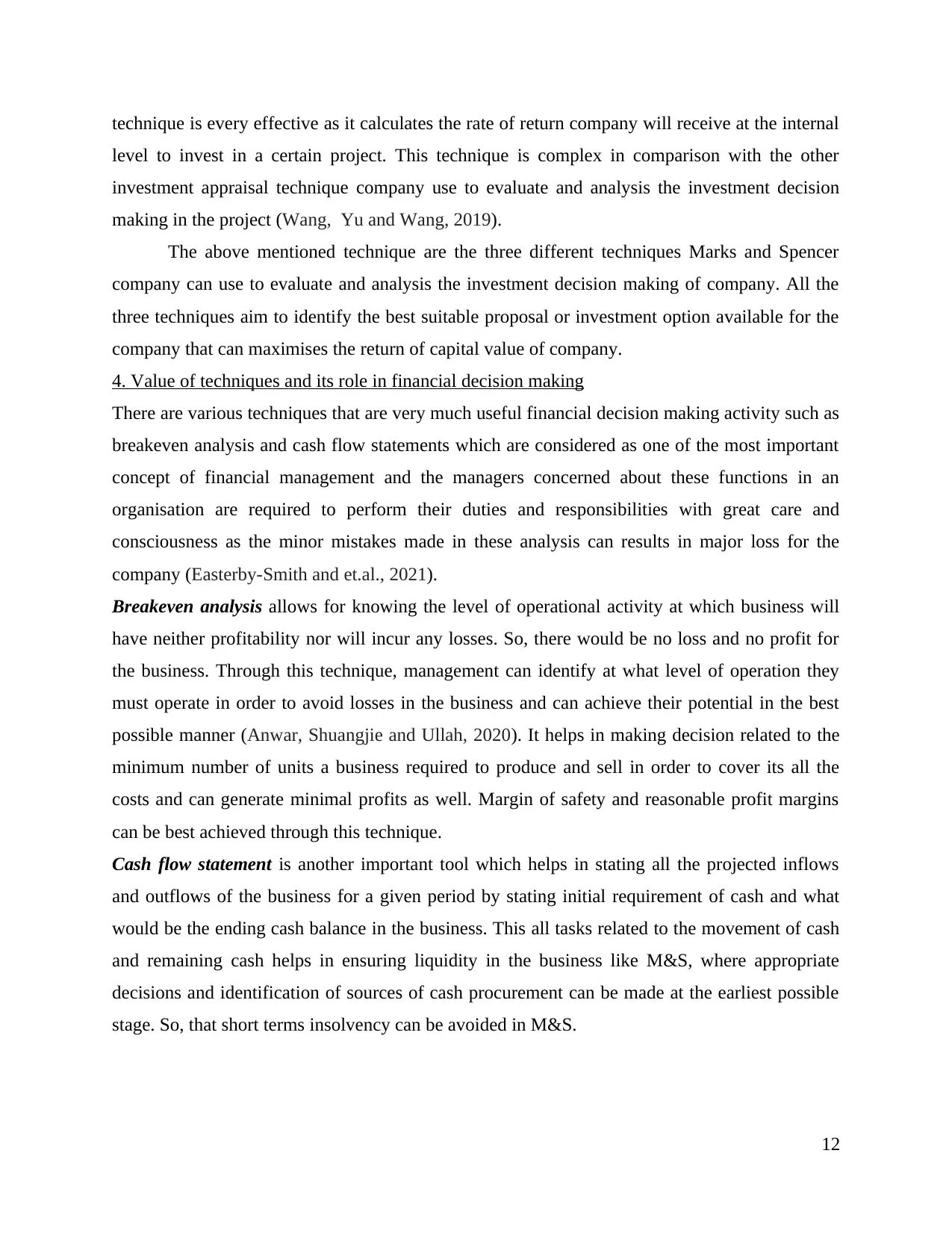
technique is every effective as it calculates the rate of return company will receive at the internal
level to invest in a certain project. This technique is complex in comparison with the other
investment appraisal technique company use to evaluate and analysis the investment decision
making in the project (Wang, Yu and Wang, 2019).
The above mentioned technique are the three different techniques Marks and Spencer
company can use to evaluate and analysis the investment decision making of company. All the
three techniques aim to identify the best suitable proposal or investment option available for the
company that can maximises the return of capital value of company.
4. Value of techniques and its role in financial decision making
There are various techniques that are very much useful financial decision making activity such as
breakeven analysis and cash flow statements which are considered as one of the most important
concept of financial management and the managers concerned about these functions in an
organisation are required to perform their duties and responsibilities with great care and
consciousness as the minor mistakes made in these analysis can results in major loss for the
company (Easterby-Smith and et.al., 2021).
Breakeven analysis allows for knowing the level of operational activity at which business will
have neither profitability nor will incur any losses. So, there would be no loss and no profit for
the business. Through this technique, management can identify at what level of operation they
must operate in order to avoid losses in the business and can achieve their potential in the best
possible manner (Anwar, Shuangjie and Ullah, 2020). It helps in making decision related to the
minimum number of units a business required to produce and sell in order to cover its all the
costs and can generate minimal profits as well. Margin of safety and reasonable profit margins
can be best achieved through this technique.
Cash flow statement is another important tool which helps in stating all the projected inflows
and outflows of the business for a given period by stating initial requirement of cash and what
would be the ending cash balance in the business. This all tasks related to the movement of cash
and remaining cash helps in ensuring liquidity in the business like M&S, where appropriate
decisions and identification of sources of cash procurement can be made at the earliest possible
stage. So, that short terms insolvency can be avoided in M&S.
12
level to invest in a certain project. This technique is complex in comparison with the other
investment appraisal technique company use to evaluate and analysis the investment decision
making in the project (Wang, Yu and Wang, 2019).
The above mentioned technique are the three different techniques Marks and Spencer
company can use to evaluate and analysis the investment decision making of company. All the
three techniques aim to identify the best suitable proposal or investment option available for the
company that can maximises the return of capital value of company.
4. Value of techniques and its role in financial decision making
There are various techniques that are very much useful financial decision making activity such as
breakeven analysis and cash flow statements which are considered as one of the most important
concept of financial management and the managers concerned about these functions in an
organisation are required to perform their duties and responsibilities with great care and
consciousness as the minor mistakes made in these analysis can results in major loss for the
company (Easterby-Smith and et.al., 2021).
Breakeven analysis allows for knowing the level of operational activity at which business will
have neither profitability nor will incur any losses. So, there would be no loss and no profit for
the business. Through this technique, management can identify at what level of operation they
must operate in order to avoid losses in the business and can achieve their potential in the best
possible manner (Anwar, Shuangjie and Ullah, 2020). It helps in making decision related to the
minimum number of units a business required to produce and sell in order to cover its all the
costs and can generate minimal profits as well. Margin of safety and reasonable profit margins
can be best achieved through this technique.
Cash flow statement is another important tool which helps in stating all the projected inflows
and outflows of the business for a given period by stating initial requirement of cash and what
would be the ending cash balance in the business. This all tasks related to the movement of cash
and remaining cash helps in ensuring liquidity in the business like M&S, where appropriate
decisions and identification of sources of cash procurement can be made at the earliest possible
stage. So, that short terms insolvency can be avoided in M&S.
12
⊘ This is a preview!⊘
Do you want full access?
Subscribe today to unlock all pages.

Trusted by 1+ million students worldwide
1 out of 16
Related Documents
Your All-in-One AI-Powered Toolkit for Academic Success.
+13062052269
info@desklib.com
Available 24*7 on WhatsApp / Email
![[object Object]](/_next/static/media/star-bottom.7253800d.svg)
Unlock your academic potential
Copyright © 2020–2025 A2Z Services. All Rights Reserved. Developed and managed by ZUCOL.





